Welcome to Moda!
Sewing Machine Care
Sewing Machine Care
From our homes to our cars, we have a to-do list for maintenance. We do the same for ourselves, or at least we try to, with diet and exercise, and a counter full of lotions and potions.
But do you have a routine for taking care of your sewing machine?
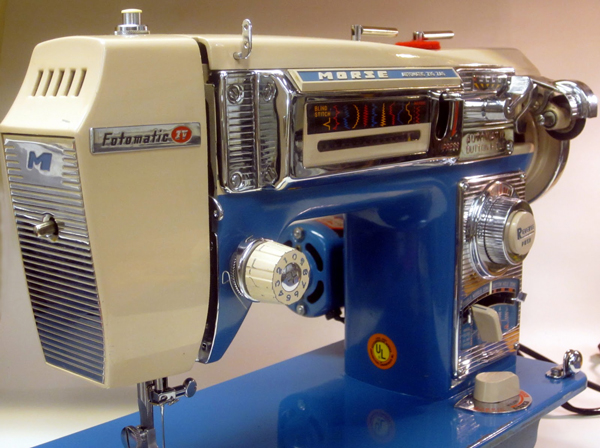
This is a 1967 Morse 4400 Fotomatic IV from the MI Vintage Sewing Machines blog.
Whether you sew for a couple hours every day, or just pulled out a sewing machine that hasn't been used in years, regular cleaning will improve the quality of the stitches, and how well the machine runs.
Over the years of teaching classes, I was often asked about my sewing machine. (Machines... plural. But that's a story for another day.) That often led to being asked about my cleaning routine, and on a few occasions, I cleaned a machine like mine to show the process. (Missing manuals happen.)
Because every machine is different, what we're sharing today is a basic overview of what needs to be cleaned, a guide to frequency, what needs to be included, and useful tools.
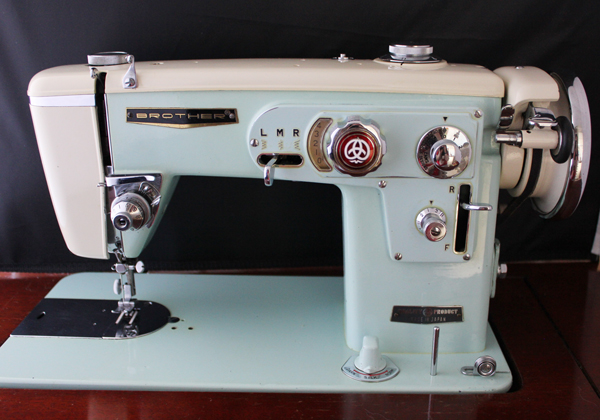
This is a Brother Super Select-o-Matic, restored by Jen at Stitchified, a lover of vintage machines.
Before I get to the basics, you should know how to clean your specific machine. For that, there are three resources:
- Sewing machine manual. Read it! Most manuals have a section on how to clean the machine, from the parts that need to be cleaned and oiled, to the frequency of cleaning recommended. Many will indicate how to remove plates and screws to expose moving parts that can be cleaned and oiled. If you don't have a manual, check the manufacturer's website as many have PDF downloads for old sewing machine manuals. If they're not listed, contact the manufacturer to see if one is available. Also check Google and eBay as out-of-print manuals are being shared online.
- Sewing machine shop - the shop where the machine was purchased, or where it is serviced. A good sewing machine shop will be happy to show you how to perform basic, routine maintenance on your particular machine. (If they won't do that, find a shop that will.)
- YouTube. Seriously, there's a video for everything so it's a good bet that someone has done a video showing how to clean the model of sewing machine you have.
So let's get to what applies to everyone.
How often should you clean your machine? If you're like most of us, the answer is probably "more often than you are now." I'm kidding! (Mostly.) Let's be honest here - most manuals and experts will say "every 4 to 6 hours of sewing", or "every 10 to 12 hours..." Whatever. Do you keep track of that? I don't. So I needed something akin to a gas guage - clean the machine when the tank is empty. Since I don't have a gas tank on my sewing machine, I used full bobbins to measure my sewing time. When I first started doing this almost twenty years ago, my guage was five bobbins. Over the years, based on my own observations and advice from Noel and Federico (sewing machine techs), that is now down to three bobbins.
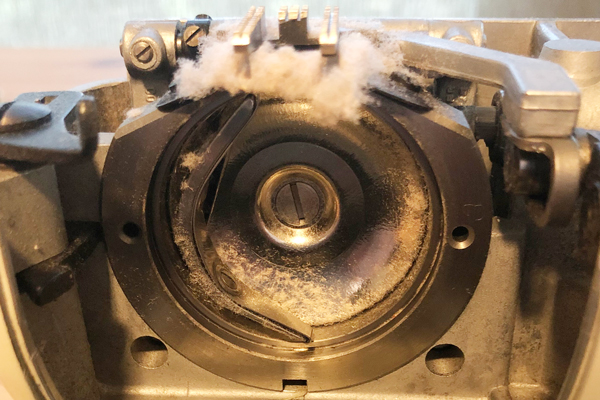
After sewing three full bobbins, my machine has a fair amount of lint. Enough to warrant cleaning. (Machine quilting. And probably more than three bobbins.)
What should your guage be - how many bobbins? There's a bit of guessing at first, then adjusting as need be. But here is what to consider:
- How much thread does your bobbin hold? Most drop-in bobbins hold less thread than those that fit into a bobbin case. The bobbins on older machines are generally smaller than those on newer machines.
- What kind of thread do you use - weight and brand? Some very high-quality threads produce a bit more lint than others. A bobbin filled with 40wt. thread will have fewer yards than the same bobbin filled with 50wt. thread. The more thread used usually means the more lint that can be produced.
- What are you sewing? Lint accumulates a lot more quickly when I'm machine quilting than when I'm piecing. Flannel? Do you have to ask?
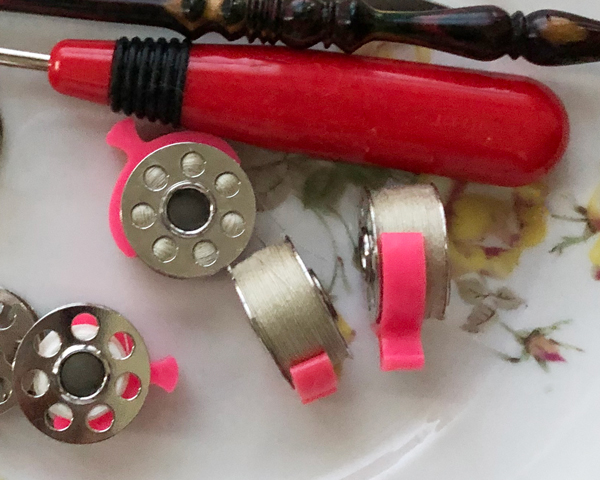
Three bobbins used... now what? This is my process.
- Raise the presser foot and remove the thread from the machine.
- Remove any extension table or plate. Open up the bobbin area and any other areas that can be cleaned and/or oiled.
- Turn off or unplug the sewing machine. Why? Because most of us sit at our machines and have our foot on the pedal without thinking about it. If you're going to be putting tools into the machine, and probably your fingers, you don't want to accidentally get it moving. (Trust me on this one.)
- Using a soft brush, microfiber wand or other cleaning tool, remove as much lint as possible. Clean off the tools and repeat the process.
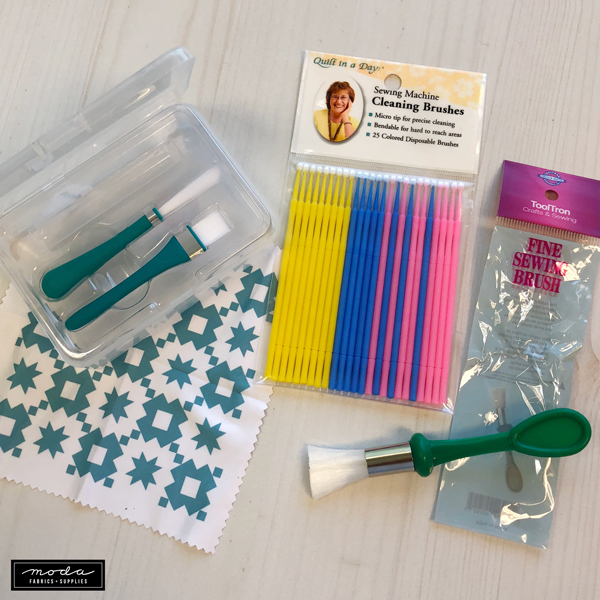
The cleaning tools shown are the Oh Sew Clean Brush & Cloth Set from It's Sew Emma (ISE 758 or ISE 759) - it includes two small brushes and a microfiber cleaning cloth. Sewing Machine Cleaning Brushes from Quilt In A Day - a set of 25 brushes in assorted colors - 4965. Sewing Machine Cleaning Brush from Tool Tron - TT00592.
- At this point, I like using a small microfiber wipe/towel to wipe down as much as possible. If there is any visible oil, it is wiped away with a scrap of fabric that I can toss when I'm done.
- Oil as directed in the manual. For my machine, there are five places that get a drop or two of oil. After the oil is applied, the machine is turned on and run for a moment or two to "work in the oil".
- Wind bobbins - three, four, however many you deem necessary for your machine.
- Change the needle. Yes - change the needle. (More on that in a moment.)
- Close up machine.
- Dust the outside of the machine.
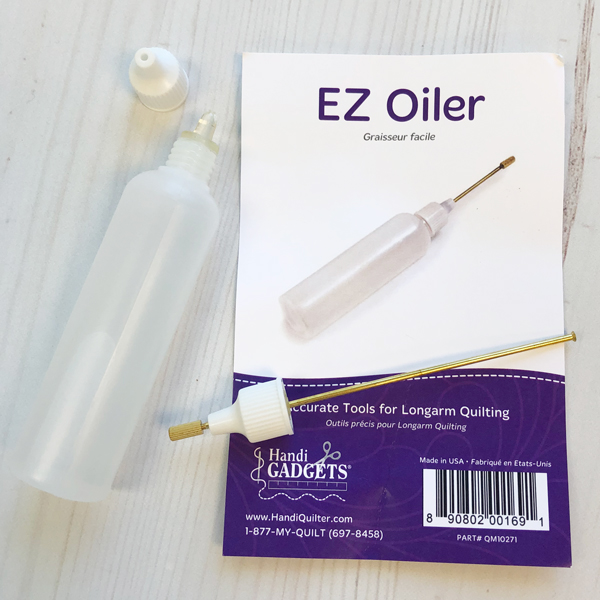
Sewing machine oil is a lightweight, clear mineral oil with no smell. It has light viscosity and will not collect on the sewing machine gears. It should be marked as being designed for sewing machines. Depending on whom you ask, sewing machine oil should not be used once it begins to turn color. This is the EZ Oiler by HandiQuilter. I like the long retractable needle-spout as it makes oiling a very specific, hard-to-reach spot an easy task.
Change the needle? Yes. The same advice given by the sewing machine folks for how often our machines need cleaning also applies to changing needles. When I first heard it, I was skeptical. It had to be a ploy to sell sewing machine needles! It didn't take long for me to notice a difference in the quality of the stitch, the sound of the machine as it hummed along. I'm betting it won't take long for you to notice a difference too.
Also - when you're removing the thread from the machine - always cut the thread at the spool and pull the length of thread out through the needle. Do not pull it "backwards" toward the spool as that can mess up the tension on the machine, especially with newer, more computerized machines.
A few more things to mention...
Spa days. If you're sewing regularly and cleaning your machine frequently, it still needs a visit to the shop for professional maintenance. Talk to your sewing machine shop to find out what's best for your machine.
Canned air. These are the cans of compressed air used for cleaning or dusting electronic equipment. For many years, canned air was very popular for "blowing" the lint out of sewing machines, and it was widely used. Then sewing machine techs began finding problems with lint having literally been blown into the gears and crevices of machines. So using it was discouraged. Compressed air is especially problematic for computerized machines.
That said, there are sewists and techs who still use it. If the machine is cleaned throughly and then the canned air is used to gently blow out any loose threads and lint... that's up to you. (I won't judge.)
Old machines. If you have a machine you love and can't imagine not having, ask your sewing machine tech if you need to get any replacement parts. I have an old Bernina that is known for having problems with the foot pedals, so I have a spare foot pedal as the parts for the machine are no longer made. I may never need it, but I have it if there's a problem. I figure it was $95.00 worth of insurance.
One last thing... there are times when I'm almost finished with a project and I run out of thread on my last bobbin. Do I quickly wind some thread so I can finish? Or do I stop everything to clean and oil my machine? I'm a little crazy but I'm not that crazy. Of course I wind a bobbin and finish what I'm sewing! And when I sit down at my machine the next time, I clean and oil my machine, and I wind three bobbins.
If it sounds like a bit much, it can be. Sometimes it feels a bit like a chore but I do it anyway because that's what I was taught when the machine was new. I had two days to sew this weekend and I cleaned my machine twice.
My forty-three year-old, still sews like a dream, sewing machine.
It was a Christmas present when I was... for when I was born.
My Dad was planning ahead.

Comments